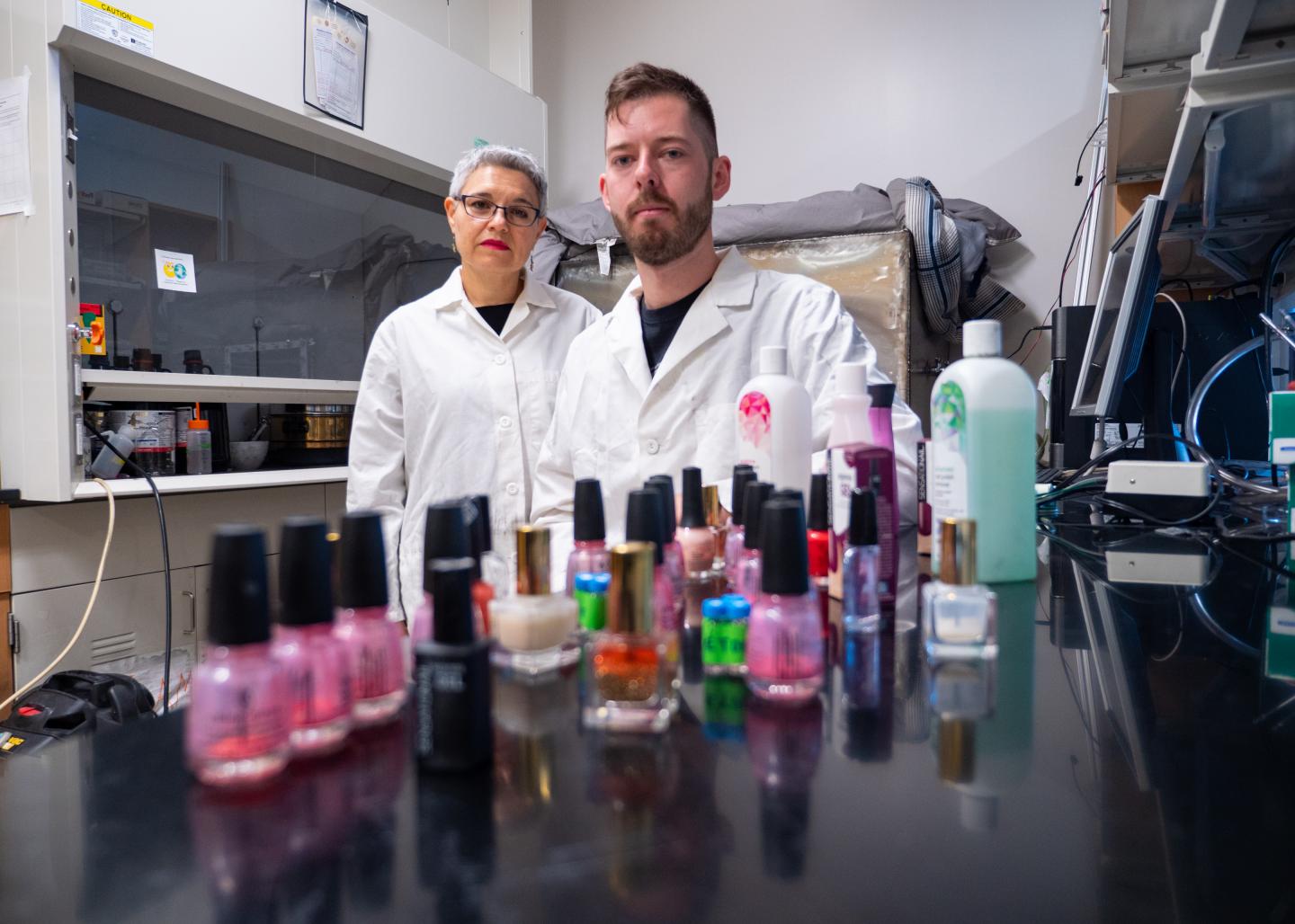
Credit: Glenn Asakawa/University of Colorado)
Colorado nail salon employees face increased health risks due to high levels of indoor airborne pollutants such as formaldehyde and benzene, new University of Colorado Boulder research finds, concluding that working in a salon is akin to working at an oil refinery or an auto garage.
The new study, which monitored volatile organic compound (VOC) levels in six Colorado nail salons, is among the first to illustrate the serious health risks prevalent in the industry, where technicians commonly work long hours and report symptoms such as headaches, respiratory difficulties and skin irritation.
The U.S. Environmental Protection Agency (EPA) has determined that long-term exposure to carcinogenic compounds significantly raises the chances of developing cancers such as leukemia and Hodgkin’s lymphoma.
“The study provides some of the first hard evidence that these environments are dangerous for workers and that better policies need to be enacted to protect them,” said Lupita Montoya, lead author of the research and Research Associate in CU Boulder’s Department of Civil, Environmental and Architectural Engineering.
Montoya’s interest in researching airborne hazards in nail salons dates back nearly a decade. She recalls visiting a salon years ago and being struck by the pungent smell of open chemicals used in gel and acrylic nail applications. The air quality couldn’t be very good in such a confined space with poor ventilation, she suspected, drawing on her background as a mechanical engineer.
But while many of the VOCs from nail products had already been identified, no scientific studies had looked at the long-term health impacts for workers exposed to them day in and day out. Which compounds were in the air at what concentrations? And once released, how could they be removed?
On two separate occasions, Montoya tried to get field tests started, but securing a location proved difficult. Over 90 percent of nail salons nationwide are small businesses, employing a predominantly minority workforce and lacking the resources to adequately address worker health and safety. Fearing consequences, many declined to participate.
“This is an issue that requires tremendous sensitivity and a respectful approach to the communities being served,” Montoya said.
In 2017, four undergraduate students working with Montoya used personal connections to help secure access to six salons for a monitoring test over the course of 18 months. The salons agreed to participate on the condition of anonymity.
The researchers set up equipment to monitor known VOCs such as benzene, toluene, ethylbenzene and xylenes (BTEX, collectively) along with formaldehyde. While formaldehyde levels were similar to those measured in other settings, the study turned up higher-than-expected concentrations of harmful benzene, which has been linked to leukemia, in all six salons.
The real concerns, the researchers say, is for workers in this industry. Montoya and her colleagues asked employees to fill out questionnaires about employment practices, safety practices and health symptoms. Technicians reported working an average of 52.5 hours per week, with some ranging as high as 80 hours per week. Seventy percent of workers reported experiencing at least one adverse symptom, with common responses including headaches, skin irritation and eye irritation.
The study found that for workers in some salons, lifetime cancer risk was up to 100 times higher than baseline EPA-issued levels.
The researchers stressed that salon customers, however, face significantly fewer risks. The observed levels of air pollution observed are unlikely to have any negative health effects on all but the most vulnerable, such as those who are pregnant or have serious asthma.
“It really depends on how much time you spend in and around that environment,” Montoya said. “Customers spend a fraction of the time in salons that workers do. Unless they have pretty severe allergies or asthma, there’s not much for customers to be concerned about.”
With the hazards readily apparent, Montoya said, the biggest question is how to remove VOCs safely and without disrupting the salon business. Montoya and her students had an answer: engineering as art.
In 2016, mechanical engineer and PhD candidate Aaron Lamplugh began working with Montoya on ways to reduce VOC concentrations passively using low-cost, absorbent materials like heat-treated coal or wood with strong affinity for organic molecules like BTEX compounds. These activated carbon materials can remove harmful VOCs through passive diffusion, but it takes a long time. Air jets that direct polluted air toward the absorbent material with greater flow provide far more efficient removal.
“We’ve seen high rates of VOC removal with this method in controlled lab settings — nearly 100 percent,” said Lamplugh, “We’re still optimizing it for the field, where conditions are more unpredictable.”
With the support of a fellowship from CU Boulder’s Nature, Environment, Science and Technology (NEST) Studio for the Arts in 2018, Lamplugh teamed up with ceramicist and MFA candidate Camila Friedman-Gerlicz to use activated carbon-based materials to create gallery-worthy artwork. The pieces could hang on the wall in a nail salon, pleasing to the eye while quietly cleaning the air.
In an ideal real-world setting, small jets would sit at the end of each table, fanning the chemical fumes directly toward the charcoal artwork, efficiently eliminating lingering VOCs.
“These materials can be beautiful, affordable and effective,” Montoya said.
Bringing engineering innovations out of the lab and into the communities that will benefit from them most is crucial, Lamplugh said.
“There’s a huge knowledge gap and a regulatory gap right now,” he said. “We should invest in technology that’s going to solve a problem on the ground, where it’s accessible and usable.”
Montoya credits her undergraduate researchers (including study co-authors Feng Xiang and Janice Trinh) with embracing that mission and dedicating themselves to research that will improve quality of life, especially in underserved communities.
“So often, technology gets stuck in the theoretical,” Montoya said. “I think our students want to help right now. It’s this new kind of engineering that will attract the next generation.”
###
Media Contact
Trent Knoss
[email protected]
Original Source
https:/
Related Journal Article
http://dx.




